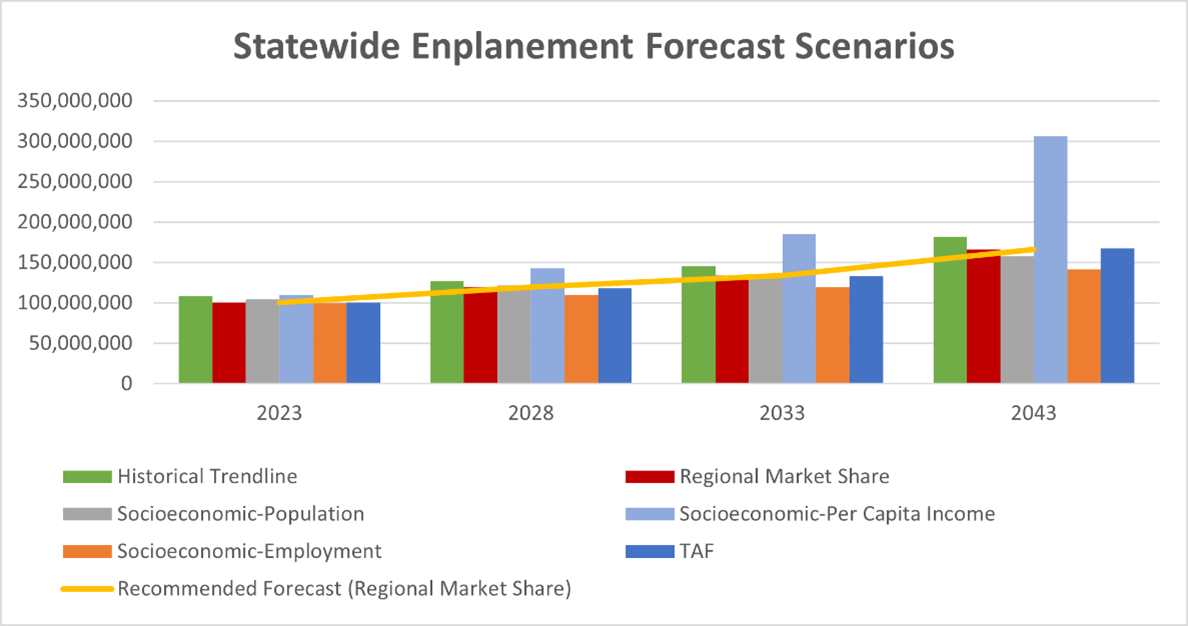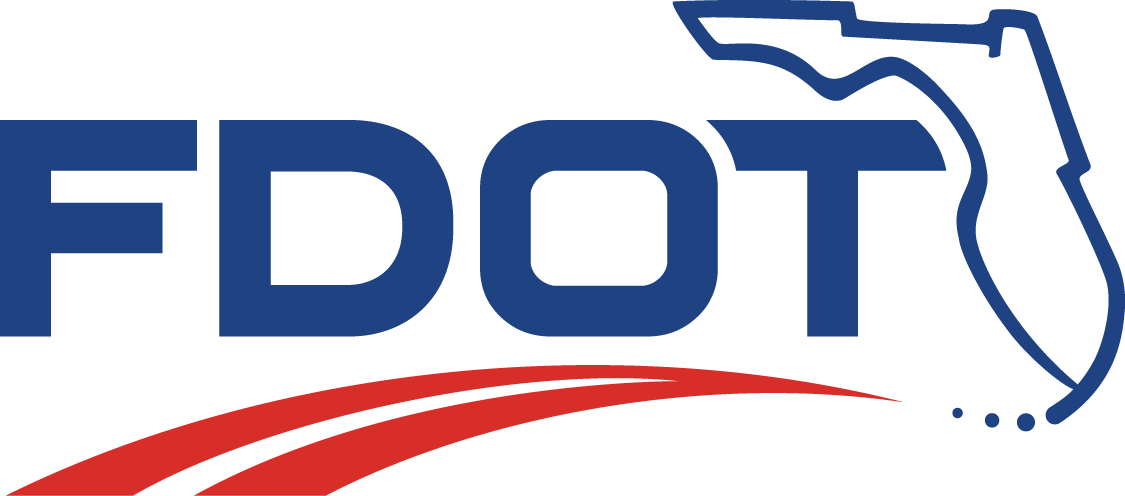.png?sfvrsn=80053e60_1)
Quick Links
The Florida Department of Transportation Aviation Office (FDOT AO) keeps the interests of the air travelers in Florida at the forefront of every decision. With more than 22 million residents and more than 137 million visitors (2022), the FDOT AO is committed to comprehensive, consistent planning that balances the widely varied interests of aviation system users with available funding and insightful project priorities. The Florida aviation system is integral to the state economy, and the FDOT AO focuses goals and objectives on providing or maintaining safety, resilience, access, and reliability to streamline business and commerce operations along with recreation and tourist activities.
The FDOT AO carries out all planning within the Florida Transportation Plan (FTP) framework and relies on assistance from the Continuing Florida Aviation System Planning Process (CFASPP) alongside the Federal Aviation Administration (FAA) and the FAA’s National Plan of Integrated Airport Systems (NPIAS). As a result, many of the system analyses are summarized at the FDOT district level, or by the airport role groupings based on NPIAS definitions. This approach better informs decisions to make the best use of the available funding and scheduling in support of ongoing operations and growth.
Florida Aviation System Plan (FASP) 2043 Process
The FASP 2043 used the FASP 2035 as its foundation and was conducted over three phases. Phase 1 focused on the assessment of goals and objectives and data collection. Phase 2 focused on the analysis of the system, while Phase 3 was focused on the development of final documents. The FDOT AO focused the 2043 update on analyzing the performance of system airports to inform decisions on actionable items that align with the funding opportunities available. Key elements of the study included emerging trends such as electrification and weather reporting tools, or methods and gaps between supply and demand, such as hangar vacancy.
Stakeholder Engagement
FASP 2043 Documents
The final products linked below are tailored to each intended audience and intentionally vary in the level of detail. Anyone wishing to see the aviation system plan from the broadest overview to the greatest details may do so. Access to each document is available at the links below.
Airport Profiles
Executive Summary
Technical Report
The Technical Report makes the study process and related data and analysis accessible to a wide audience. Each chapter includes the essential information gleaned from the study and used in decision-making. As a result, following the introduction and the history chapters, the remaining chapters each focus on one or two main components. The chapters discuss key takeaways and findings and build toward the final chapter of recommendations. All technical report chapters are linked below, and each chapter points to the associated appendix or appendices, as appropriate, for those who wish to go deeper into the analysis details and documentation. A PDF containing the Full Technical Report (except for Appendix E FASP 2043 System Analysis, which is an Excel spreadsheet) combines the entire Technical Report into a single document.
List of Common Abbreviations and Acronyms
Chapter 1 - Study Introduction
Chapter 1 introduces the study, describes responsible parties and agencies or organizations who influence the system plan, and explains the stakeholder engagement plan. Appendix A Stakeholder Engagement provides additional details regarding the various efforts used to involve the aviation industry in the FASP 2043.
Chapter 2 - History and Recent Impacts
Chapter 2 describes the historic role of aviation in Florida and discusses impacts to the entire Florida Aviation System from the COVID-19 pandemic as well as initial recovery data (2022).
Chapter 3 - Airport System NPIAS Classifications
Chapter 3 discusses the NPIAS roles and categories of Florida airports. The discussion features information about how NPIAS eligibility factors into the implementation of initiatives and why retaining or advancing roles in the NPIAS is important. The chapter includes a matrix that identifies Florida airports by role, category, FDOT district, and CFASPP region for a comprehensive overview of where these factors intersect. Some of these factors served as a basis for assessing the findings of the performance of the Florida airport system. System performance is discussed in Chapter 7 System Analysis.
Chapter 4 - System Goals
The FDOT AO has established goals and objectives in each system plan, which underwent a refresh for the FASP 2043. Chapter 4 details the goals and objectives selected to guide the analysis and decisions as this study progressed. This step was critical to informing the remaining steps in the study process and determined the data collection efforts going forward. Appendix B Goals and Performance Measures provides additional details that support Chapter 4.
Chapter 5 - Data Collection and Inventory
For any study process to remain credible, the data must be sound. Chapter 5 details the methods used to collect the data and relays the highlights and trends that the data reviewed in light of the stated goals and objectives. Appendix C Airport Activity/Emerging Trends Survey Results provides a summary of the initial data collected via surveys of airport managers and FDOT AO staff.
Chapter 6 - Aviation Activity Forecasts
 Activity forecasts are critical to evaluating needs and demands related exclusively to aviation activity. Chapter 6 summarizes the methods used to asses existing aviation activity and project future activity at Florida’s system airports. The chapter also discusses recommended forecast scenarios for based aircraft, general aviation operations, commercial/air taxi operations, and enplanements. Appendix D Aviation Activity Forecasts provides greater detail of these various scenarios.
Activity forecasts are critical to evaluating needs and demands related exclusively to aviation activity. Chapter 6 summarizes the methods used to asses existing aviation activity and project future activity at Florida’s system airports. The chapter also discusses recommended forecast scenarios for based aircraft, general aviation operations, commercial/air taxi operations, and enplanements. Appendix D Aviation Activity Forecasts provides greater detail of these various scenarios.
Chapter 7 System Analysis
Chapter 7 delves into the performance measures and performance indicators derived from the goals and objectives identified in Chapter 4 System Goals. Most of the chapter focuses on performance of airports by district, but for several measures or indicators, it also highlights performance relative to NPIAS roles. This chapter also describes the geographic system analysis using drive-times to determine state population access to various services and infrastructure. The full data set is viewable in a spreadsheet contained in Appendix E FASP 2043 System Analysis.
Chapter 8 Aviation Office Initiatives
As the study progressed and trends began to emerge during data collection, the FDOT AO selected the topics related to emerging trends as well as select initiatives that merited additional analysis. Chapter 8 describes the topics in general, along with greater definition of the four topics selected for a deeper dive. The chapter explains the significance of the four selected topics in terms of potential initiatives for the near-term, and full details for all topics can be found in the following appendices:
- Appendix F – Weather Reporting Systems Initiative
- Appendix G – Airport Electrification Initiative
- Appendix H – Hangar Demand Initiative
- Appendix I – Stormwater Management Program Initiative
- Appendix J – Unleaded Avgas Emerging Trends
- Appendix K – Sustainable Aviation Fuel Emerging Trends
- Appendix L – Power Alternatives Emerging Trends
- Appendix M – Resource Management Emerging Trends
Chapter 9 Funding
Improvements cannot be pursued without the funding to pay for the development. Chapter 9 focuses on the funding available to improve Florida’s system airports, including state and federal sources. Additional analyses include an assessment of FDOT’s Joint Automated Capital Improvement Program (JACIP) demands compared to funding available.
Chapter 10 System Recommendations
The final chapter pulls everything together by identifying the key findings and recommendations from the three-phase study. This chapter includes recommendations for the FDOT AO initiatives discussed in Chapter 8, NPIAS recommendations discussed in Chapter 3, and system performance findings outlined in Chapter 7.
Appendices
Appendix A – Stakeholder Engagement
Appendix B – Goals and Performance Measures
Appendix C – Airport Activity/Emerging Trends Survey Results
Appendix D – Aviation Activity Forecasts
Appendix E – FASP 2043 System Analysis (Spreadsheet)
Appendix F – Weather Reporting Systems Initiative
Appendix G – Airport Electrification Initiative
Appendix H – Hangar Demand Initiative
Appendix I – Stormwater Management Program Initiative
Appendix J – Unleaded Avgas Emerging Trends
Appendix K – Sustainable Aviation Fuel Emerging Trends
Appendix L – Power Alternatives Emerging Trends
Appendix M – Resource Management Emerging Trends
For those who are interested in reviewing the findings of the FASP 2035 System Plan Update, click here.

